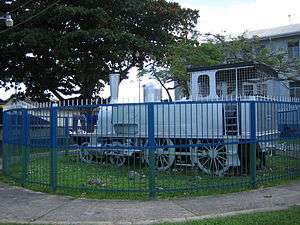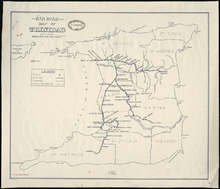Trinidad Government Railway

The Trinidad Government Railway existed between 1876 and 28 December 1968. Originally built to connect Port of Spain with Arima, the railway was extended to Couva in 1880, San Fernando in 1882, Cunapo (now Sangre Grande) in 1897, Tabaquite in 1898, Siparia in 1913 and Rio Claro in 1914.
Background

The first attempt to establish a railway was a private affair in 1846 by the Trinidad Railway Company.[1]
Overview
At this, its greatest extent, the railway covered 173 km (107 mi).[2]
After the end of World War I, the appearance of the automobile led to changes that culminated with the phased closure of the railway April 1953 and 28 December 1968 saw the complete closure of the Trinidad Government Railways.
Statistics
The TGR appeared to have 640 route-km and was standard gauge (1,435 mm (4 ft 8 1⁄2 in)).[3]
Stations
The principal stations, terminii and junctions are:
- Port of Spain - terminus, capital and port
- Tunapuna - junction in east
- Sangre Grande - terminus in east
- Tunapuna - junction in east
- Chaguanas - junction in south east
- Gasparillo - junction
- Princes Town - terminus
- Gasparillo - junction
- San Fernando - town in south
- Penal - town
- Siparia - terminus in south
New railway
On 11 April 2008 the Trinitrain consortium was chosen to plan and build two new Trinidad Rapid Railway passenger lines.This plan was cancelled in 2010.[4]
References
- ↑ "History". Public Transport Service Corporation on. Retrieved 2013-10-20.
- ↑ Anthony, Michael (2001). Historical Dictionary of Trinidad and Tobago. Scarecrow Press, Inc. Lanham, Md., and London. ISBN 0-8108-3173-2.
- ↑ "Railroad Gauge Width". Parovoz.com. Archived from the original on 11 January 2013. Retrieved 2010-01-12.
- ↑ "Trinidad rapid rail consortium confirmed". Railway Gazette International. 2008-04-11.